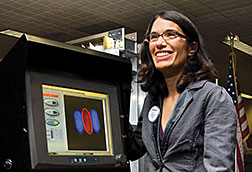- Number 407 |
- February 17, 2014
Michelle Espy: Detecting dangers to support health and security

Los Alamos physicist Michelle Espy
demonstrates use of a magnetic field
detector to screen carry-on liquids at
airports.
In high school, Michelle Espy became fascinated by science after discovering that rules governed how the universe worked and things weren’t totally random. After receiving her Ph.D. in physics in Minnesota, she joined DOE's Los Alamos National Lab as a young postdoc in 1996 to investigate brain imaging, cardiac and cancer research.
Espy applied physics methods to the noninvasive study of the human brain, and she and her team applied similar methods to a whole host of different kinds of problems, too, including work on detection of liquid explosives hidden inside carry on luggage at the airport.
Now a Team Leader at the Lab, Espy and her team advanced magnetic resonance imaging technology that may allow for a breakthrough for screening liquids at airport security, adding low-power X-ray data to the existing MRI technology to unlock a new way to detect dangerous liquids using a system known as MagRay. The goal of MagRay is to help airport security to distinguish between visually identical liquids.
“One of the challenges for the screening of liquids in an airport is that, while traditional X-ray based baggage scanners provide high throughput with good resolution of some threats, there is limited sensitivity and selectivity for liquid discrimination,” said Espy, the project’s leader. “While MRI can differentiate liquids, there are a certain class of explosives, those that are complex, homemade, or may have mixes of all kinds of stuff that are more challenging.”
For instance, while a bottle of white wine would be perfectly safe on a commercial aircraft, a bottle of the similarly clear liquid nitromethane could be used to make an explosive. MagRay is able to distinguish between harmless and hazardous liquids, and it’s easy to use.
“We’ve been able to look at a really broad class of explosives, we’ve been able to look through all kinds of packaging, and we’ve unlocked a new parameter – proton content – that’s not available to either X-ray or MRI alone.” Espy added.
MagRay was founded on the work of Espy’s two other similar projects, CoilViz and MagViz, winner of an R&D100 award.
Espy is also helping a Los Alamos team determine how plants die during drought, one of the largest uncertainties in determining how plants will succumb to changing climate.
For the first time ever, the team determined that water content can be monitored non-invasively and unobtrusively in intact trees via ultra-low field (ULF) nuclear magnetic resonance (NMR). Espy developed the ULF MRI system using Superconducting Quantum Interference Devices (SQUIDs) she devised.
Watch Espy discuss what inspires her in this profile video.
Hear Espy discuss MagRay in a video on Los Alamos National Laboratory YouTube channel, where you can also view videos about the Lab’s tree death study.Submitted by DOE's Los Alamos National Laboratory
